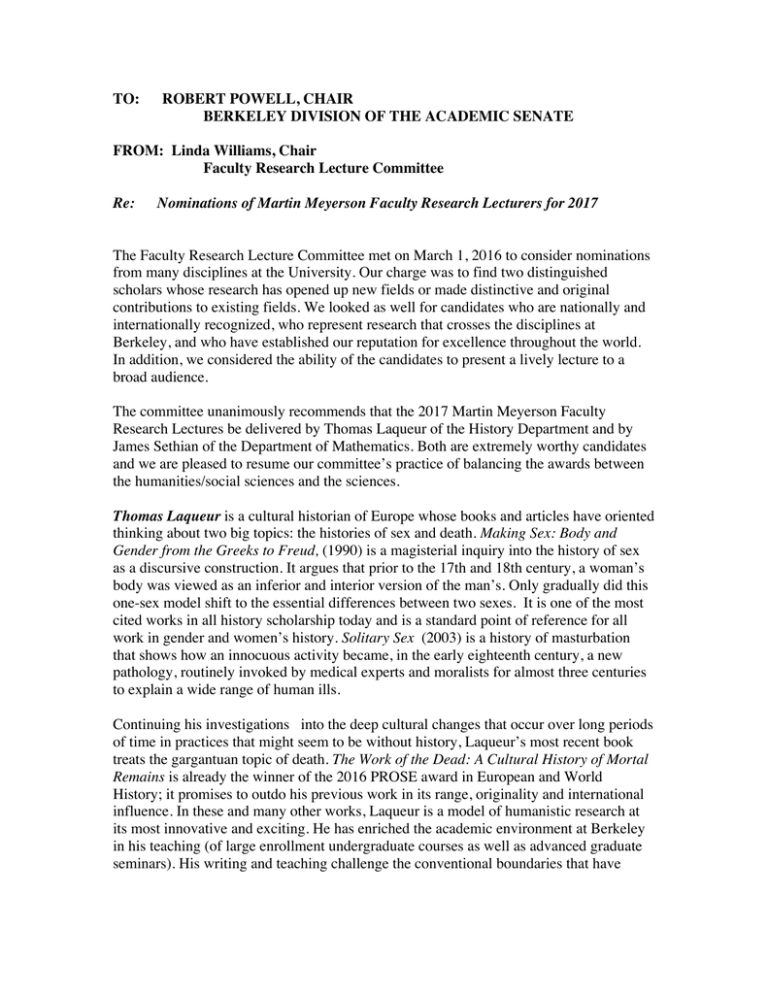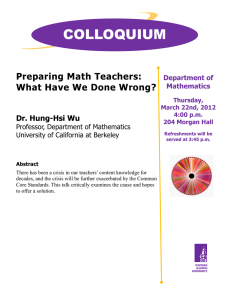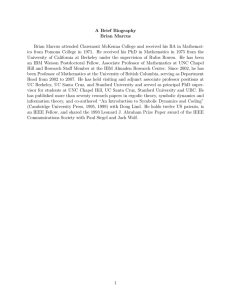TO: ROBERT POWELL, CHAIR
advertisement

TO: ROBERT POWELL, CHAIR BERKELEY DIVISION OF THE ACADEMIC SENATE FROM: Linda Williams, Chair Faculty Research Lecture Committee Re: Nominations of Martin Meyerson Faculty Research Lecturers for 2017 The Faculty Research Lecture Committee met on March 1, 2016 to consider nominations from many disciplines at the University. Our charge was to find two distinguished scholars whose research has opened up new fields or made distinctive and original contributions to existing fields. We looked as well for candidates who are nationally and internationally recognized, who represent research that crosses the disciplines at Berkeley, and who have established our reputation for excellence throughout the world. In addition, we considered the ability of the candidates to present a lively lecture to a broad audience. The committee unanimously recommends that the 2017 Martin Meyerson Faculty Research Lectures be delivered by Thomas Laqueur of the History Department and by James Sethian of the Department of Mathematics. Both are extremely worthy candidates and we are pleased to resume our committee’s practice of balancing the awards between the humanities/social sciences and the sciences. Thomas Laqueur is a cultural historian of Europe whose books and articles have oriented thinking about two big topics: the histories of sex and death. Making Sex: Body and Gender from the Greeks to Freud, (1990) is a magisterial inquiry into the history of sex as a discursive construction. It argues that prior to the 17th and 18th century, a woman’s body was viewed as an inferior and interior version of the man’s. Only gradually did this one-sex model shift to the essential differences between two sexes. It is one of the most cited works in all history scholarship today and is a standard point of reference for all work in gender and women’s history. Solitary Sex (2003) is a history of masturbation that shows how an innocuous activity became, in the early eighteenth century, a new pathology, routinely invoked by medical experts and moralists for almost three centuries to explain a wide range of human ills. Continuing his investigations into the deep cultural changes that occur over long periods of time in practices that might seem to be without history, Laqueur’s most recent book treats the gargantuan topic of death. The Work of the Dead: A Cultural History of Mortal Remains is already the winner of the 2016 PROSE award in European and World History; it promises to outdo his previous work in its range, originality and international influence. In these and many other works, Laqueur is a model of humanistic research at its most innovative and exciting. He has enriched the academic environment at Berkeley in his teaching (of large enrollment undergraduate courses as well as advanced graduate seminars). His writing and teaching challenge the conventional boundaries that have walled off major areas of human experience from one another: the biological from the social, the social from the aesthetic, the aesthetic from the political. Laqueur has received a great many honors and awards, including a fellowship at the Institute of Advanced Study, a Mellon Grant, Guggenheim, Rockefeller, and NEH fellowships as well as election to the American Academy of Arts and Sciences. He is also a public intellectual who contributes to The London Review of Books, The Threepenny Review and the New Republic. All of his letter writers stress what an exciting lecture he will give. James Sethian is an applied mathematician who has invented foundational algorithms for studying how interfaces move and evolve. His mathematical insights and leadership have been instrumental in making UCB and Lawrence Berkeley National Laboratory preeminent institutions in applied mathematics and computational science. Almost every key problem in science and technology involves dynamic interfaces of one sort or another – foams, flames, fracture in metallic glasses, soap bubbles, living cells and tissues, computer chip manufacturing, and medical image analysis are only a few of the many areas that have been influenced deeply by the algorithms and tools he has created. The importance of these dynamical systems is widely recognized but it is frequently assumed that they are too hard to tackle by direct calculation. Most often, ad hoc toy models are created in the various fields but quickly prove to have limited value and are thus forgotten. Sethian has been pursuing a different approach: he listens carefully to scientists in a field that is new to him, reduces the phenomena they are studying to the relevant underlying laws of physics and mechanics, and then uses his remarkable computational tools to calculate accurately how those systems will evolve forward in time. Most recently, Sethian has been able to perform the first ever three dimensional calculations of how groups of biological cells respond to defined external loads and also how these cell clusters change their shape and architecture when brought into contact with different materials, such as collagen matrices. The movies produced by his calculations are so realistic that many biologists first think they are looking at experimental data rather than the output of a computer algorithm. His work shows that we can begin to think of using computers to help us understand how biological tissues form and how they disorganize, not based on ad hoc toy models but on accurate calculations. As expected, Sethian has received great recognition from his peers: the 2004 Norbert Wiener Prize in Applied Mathematics, election to the National Academy of Engineering, a 2011 Pioneer Award from the International Council for Industrial and Applied Mathematics for introducing mathematical methods and scientific computing techniques to solve industrial problems. He is also a renowned teacher and gifted lecturer.



